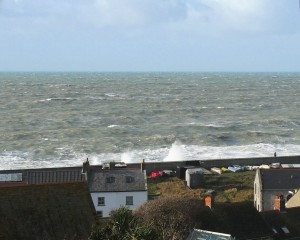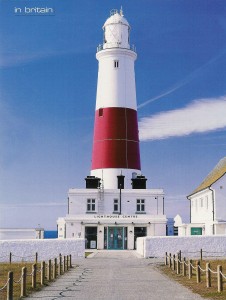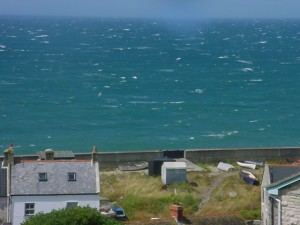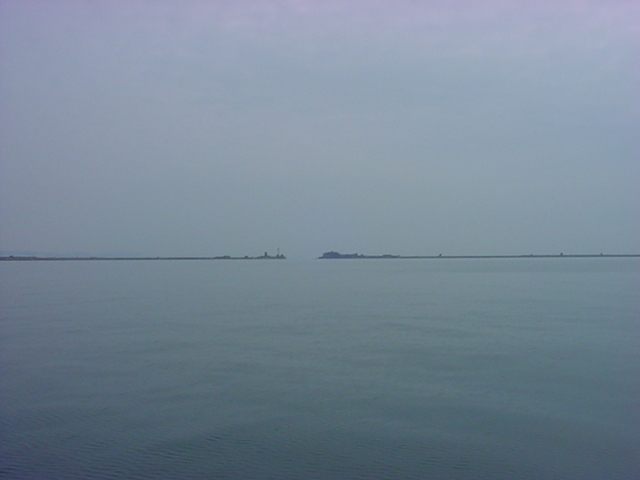Driving across the causeway to the island this morning I nearly swerved off the road when a kingfisher suddenly shot past and flew alongside me, its short sharp beak and the rapid flapping of its wings instantly distinctive, more so even than its brilliant colouring in the dark, misty drizzle that’s descended on us today. It seems odd to see kingfishers right by the sea, but we’ve seen them flying along the edge of Portland harbour now for three winters in a row.
Christopher Stocks
Island Life
Recent Posts
Categories
When the wind blows
 Living three miles out to sea has its advantages (more sunshine than average, later sunsets, cleaner air…) but when we get a south-westerly gale like the one that’s been raging for the last couple of days we really get it in the neck. Everything booms and rattles all day and all night, the salt spray burns our precious plants, and my study windows get so thickly coated with oily spray that I can hardly see outside. Even a walk to the end of the street leaves you breathless, completely dishevelled and slightly sticky with salt.
Living three miles out to sea has its advantages (more sunshine than average, later sunsets, cleaner air…) but when we get a south-westerly gale like the one that’s been raging for the last couple of days we really get it in the neck. Everything booms and rattles all day and all night, the salt spray burns our precious plants, and my study windows get so thickly coated with oily spray that I can hardly see outside. Even a walk to the end of the street leaves you breathless, completely dishevelled and slightly sticky with salt.
On days like these I’m thankful for our foot-thick Portland-stone walls, which must have witnessed many gales far worse than this, such as the Great Gale of November 1824 (more colourfully known as The Outrage) which breached Chesil Beach, drowned 25 islanders, swept away the old ferry across the Fleet and even, a mile or two inland, blew a farmer’s turnips clean out of the ground.
Condé Nast Traveller feature
On a good day, as you crest the summit of the island, it’s like being on the biggest pier in the world. The land falls away from you in all directions, and beyond it, dazzling and blue, is the sea, and you feel like a master of the universe. The wind can take your breath away. The coast is treacherous. The landscape is bizarre. But the Isle of Portland, tethered to Dorset only by the fragile ribbon of Chesil Beach, inspires strong feelings and fierce patriotism. To those who’ve been converted, it’s like nowhere else on earth.
It’s certainly like nowhere else in England. Dorset may be the county that time forgot, an Enid Blyton land of lost valleys and lush green fields and villages with made-up names, but at Weymouth, just when you think that Dorset has finally come to an end, there it is: the Isle of Portland, looming like Gibraltar from the jolly Dorset waves, its top often brooded over with cloud, its cliffs plunging into the sea.
Portland has always been an oddity. Neither a true island nor – except in the most tenuous sense – really part of the mainland, it has belonged to the Crown since William the Conqueror decided to keep it for himself instead of giving it to his noble supporters. It’s this, as much as its unusual geography, which has given Portland its engagingly anarchic charm. For while the rest of Dorset continues to be discreetly dominated by the landed gentry, Portland has always been a toff-free zone, combining the physical allure of Capri with the social cachet of Canvey Island.
 For those with an adventurous turn of mind it’s a fascinating destination: just three hours from London but as alien as Kazakhstan. OK, so you’re not, as yet, going to find design hotels and gastropubs, but you will be joining an intriguing bunch of early adopters – writers, artists, sculptors, divers, climbers, Jarvis Cocker, even, it’s rumoured, Prince Charles – who’ve been attracted by its spectacular views, its extraordinary landscape, its geology, its peculiar sense of isolation, its crystal-clear waters, brilliant light and, it has to be said, its property prices, which have so far remained enticingly low.
For those with an adventurous turn of mind it’s a fascinating destination: just three hours from London but as alien as Kazakhstan. OK, so you’re not, as yet, going to find design hotels and gastropubs, but you will be joining an intriguing bunch of early adopters – writers, artists, sculptors, divers, climbers, Jarvis Cocker, even, it’s rumoured, Prince Charles – who’ve been attracted by its spectacular views, its extraordinary landscape, its geology, its peculiar sense of isolation, its crystal-clear waters, brilliant light and, it has to be said, its property prices, which have so far remained enticingly low.
For the first-time visitor, first impressions can be distinctly unpromising. The only approach road takes you through the scraggy Weymouth suburb of Wyke Regis, so it’s a relief when you emerge on the two-mile causeway across the dunes, Portland Harbour to your left and the vast pebble bank of Chesil Beach to your right. Ahead rises Portland’s 500-foot-high northern flank, disfigured by a century of naval occupation but still undeniably imposing. Though the causeway is the only way on and off the island by car, an enjoyable summer alternative is to take the foot-passenger ferry from Weymouth harbour to Portland Castle, which has the added advantage of avoiding Wyke.
The island itself is divided between what Portlanders call Tophill and Underhill. Tophill, as the term suggests, encompasses the island’s upper (and larger) part, a flat, treeless plateau which slopes gradually down to its southern tip – the famous Portland Bill – and includes the sprawling villages of Easton, Weston and Southwell. Tophill’s weird moonscape is largely a product of its quarries, and its stone-built villages, with their broad, long greens and scatters of ancient houses, seem to have more in common with Derbyshire than Dorset. The steep landward escarpment is known as Underhill, with Castletown and Chesil at its base and Fortuneswell clinging to its side. Even today, Tophill and Underhill are linked only by a single precipitous road, constructed in the early 19th century to replace an even steeper route, a near-vertical incline, now demoted to a footpath, that still offers the physically fit a short but challenging climb.
Portland is just a mile and a half wide by four and half miles long, so it doesn’t take long to quarter by car. But it’s the rambler who really discovers the island. Fortuneswell, in particular, hides its secrets from passing traffic, which thunders along its sunless high street on its low-gear grind to the top. Ample free parking is another Portland attraction, so leave your car and explore the narrow lanes that plunge down from the high street to the sea, their old stone cottages still much as Thomas Hardy described them: ‘The houses above houses, one man’s doorstep rising behind his neighbour’s chimney, the gardens hung up by one edge to the sky, the vegetables growing on apparently vertical planes…’ Walk down Mallams, King Street or Spring Gardens and you could be in St Ives – just minus the tourist tweeness and the Tate.
On Tophill, too, the best things come to those who walk. For those with time and stamina, the ten-mile circuit of the beetling crags rewards the walker with spectacular views. Thanks to its six-mile projection into the sea, Portland has a grandstand view of the so-called Jurassic Coast, the country’s first natural UNESCO World Heritage Site, of which it forms a central part. To the east are the receding planes of Purbeck chalk, original home of the Famous Five; to the west is the scimitar curve of Chesil Beach, that vast and still-puzzling natural phenomenon – a bank of shingle 18 miles long which peels away from the mainland at Abbotsbury and ends in Portland at Chesil Cove. On a clear day, far beyond, you can see the peaks of Dartmoor rising like Atlantis from the sea.
And to the south? To the south is Portland Bill, a windswept promontory, still semi-rural, its close-cropped turf bright with pink thrift and yellow horse-shoe vetch. A notorious peril to shipping even after all three of its lighthouses were built, the Bill has a character all its own. The ubiquitous cliffs are lowest here, and on a rough winter’s day the seaspray blows right over the fields. There’s no more exciting place to be in a storm, the rock of Portland underfoot while the seas rage all around you. It’s an unearthly spot at the best of times, but what makes it positively spooky is the infamous Portland Race. Like Chesil Beach it’s a natural phenomenon, caused by Portland’s obstruction to the normal tidal flow.
Jonathan Raban describes it brilliantly in Coasting: ‘The eddies created by this curious obstruction to the tidal stream cause a continuous southward swirl of current on both sides of the Bill. This current drives at right-angles straight into the main flow of the stream which goes east on the flood and west on the ebb. Such a meeting of opposed bodies of water would cause confusion anywhere, but off the Bill the effect is violently exacerbated by a broad, shallow ledge of shingle, coral, stone and broken shells. The tide, finding itself abruptly baulked in midstream, pours over the uneven bottom of the ledge at tremendous speed, like water from a hose whose end has been squeezed between forefinger and thumb. When it is further inflamed by a contrary wind, the sea on the ledge turns to boiling milk. Water stands on its end in foaming pillars. It seethes and hisses and growls.’
In stormy weather the Race is an added thrill, but on a calm day it can be uncanny, as great plumes of water spurt 50 feet into the air from an otherwise gentle sea. Despite the car park, the defence research bunkers and the summer crowds, the Bill still feels remote; until the 1920s it didn’t even have a proper road. Its remoteness is probably what attracted Marie Stopes, who bought the appropriately phallic old Higher Lighthouse in 1923 and used it as a holiday home until her death in 1958. However difficult her personality – George Bernard Shaw called her ‘Dottissima’ – Stopes had no shortage of charisma, and during her tenancy the lighthouse played host to everyone from HG Wells to Thomas Hardy, Barnes Wallis to Margot Fonteyn.
Until relatively recently it wasn’t just Portland Bill that was remote: the island was only connected to Dorset by a bridge as late as 1842, after the ancient ferry (and its ancient ferrymen) were swept off in a famous storm known locally as The Outrage. In earlier times Portland’s tiny population eked out a precarious living from agriculture, when not suffering from one of the almost Blackadderish setbacks that beset so many Medieval communities: pirate raids, bubonic plague, the French. The soil, surprisingly, was rich and supported plentiful crops, but there were never many trees and, because of that, cowpats and sheep’s dung became a much fought-over commodity both as fertiliser and as fuel.
This bucolic idyll might have juddered along for a couple of centuries longer had not Inigo Jones, Britain’s first great Classical architect, chosen Portland stone for his masterpiece, the Banqueting House in London. Commissioned for Whitehall Palace in 1619, the Banqueting House still stands, the first big chunk of Portland to be lugged off to the capital and the last thing Charles I saw before he lost his head.
Over the next 300 years, as the craze for Portland stone took hold, the island’s landscape was transformed. The Great Fire of London gave Portland its biggest early boost, as Sir Christopher Wren chose Portland stone to rebuild the City’s churches – and its cathedral, St Paul’s. It’s often claimed that there’s more Portland stone in London now than there is left on the island itself, but whatever the truth of the matter, London wouldn’t look the same without it. Buckingham Palace, Waterloo Bridge, the National Gallery, Somerset House, Tate Britain, St Paul’s, the Monument, the whole of Regent Street – their creamy-white facades all bear testament to the toughness and beauty of Portland stone.
At first the quarrymen simply chipped away at the island’s cliffs, tipping the rough-cut rocks over the edge and loading them onto barges down below. In the pre-railway age it was far more straightforward to transport the stone by sea than by land, but with the coming of the Industrial Revolution, the quarries moved inland, destroying the old fields and burying the undercliffs in rubble. Even today, the shoreline is littered with squared-off blocks of stone, waiting for a barge that never came, as unearthly, in their way, as the statues of Easter Island.
Portland continues to attract sculptors and stonemasons, as a visit to the Tout Quarry sculpture park reveals. This long-abandoned excavation is dotted with unsigned work by sculptors both professional and amateur, and half of the pleasure is trying to work out who did what – is that an Anthony Gormley? (It is.) Could that be by Andy Goldsworthy? (It could, but no one seems entirely sure.) Tout Quarry is also atmospheric in its own right, with its dry-stone arches, rock pillars and man-made valleys that bring you out, unexpectedly, to the edge of the cliffs, with the powder-blue sea shimmering 400 feet below.
These cliffs, and the superbly clear waters below them, are the keys to two of Portland’s other big attractions: rock-climbing and diving. As regular climber Fiona McGowan explains, ‘Portland is Britain’s only major bolted crag. That means you don’t have to take so much clobber with you – just a few quickdraws and a rope – so you can do steeper and harder climbs, and do more of them during the day.’ McGowan, a glamorous Sandra Bullock lookalike who combines climbing with writing and subediting magazines, loves the sport’s sociability, and the fact that Portland offers so many different climbs in such a compact space.
‘Pretty much all the rocks around Portland are climbable, so you can choose a cliff that has plenty of routes within your grade. Or you can decide to climb on cliffs that get lots of afternoon sunshine. If it’s cold, you might choose a cliff that is sheltered from, say, the north-westerly wind. If it starts to drizzle, you can move to the quarried rock inland where you’re reasonably sheltered from the wind and the rain.’
Divers are irresistibly drawn to Portland too, as you’ll see if you swim at Chesil Cove, a deep pebbled bay where Portland and Chesil Beach meet. Here, almost every calm weekend of the year, wetsuited divers swarm like human beetles, attracted not just by waters of near-Mediterranean clarity but also by the wrecks that litter this dangerous coast. Chesil Beach and Portland were – and still are – justly feared by mariners, and there are something like 50 diveable wrecks within easy reach of the Isle, including two U-boats and the HMS M2, a submarine that, perhaps unwisely, boasted hangar doors, which sank in 1932.
Stone may have fuelled Portland’s economy, but because of its strategic position, until recently it was, to quote from Simon Jenkins’ best-selling England’s Thousand Best Churches, ‘left to the mercy of the philistine Royal Navy. Its quaint streets and cliffs… battered less by storms and centuries of quarrying than by dreadful naval buildings.’ Jenkins goes on to give a star to St George, Reforne, a Georgian gem and the wayward masterpiece of local architect-quarryman Thomas Gilbert, who also designed Queen Anne House in Fortuneswell. St George’s deserves a visit, not only for its Hawksmoor-like outline and its intact interior (only too rarely open), but for its haunting setting and its extraordinary graveyard, packed with beautiful examples of the stonemason’s art and tragic memorials to lives lost at sea.
The Navy, as Simon Jenkins suggests, has a lot to answer for. It may have provided plenty of local employment, but its departure in 1995 left Portland disfigured by research blocks, fuel tanks, barracks and housing estates that had never made any attempt to blend in with their surroundings. Now, though the eyesores remain, the island seems to be recovering its battered self-esteem, with ambitious regeneration plans afoot. One of the most potentially exciting ties in with London’s bid for the 2012 Olympics. If London wins the Games, Portland Harbour, one of the world’s finest man-made deep-water ports, is where the sailing events will be held; the British Olympic team already trains here, at the highly regarded sailing school.
But if Portland could do with a bit of smartening up (a really good restaurant would be a start), it would be sad if it turned into a second St Ives or a supplementary Southwold. Much of its character comes from its cranky, couldn’t-care-less attitude to the outside world which manifests itself, among other things, in a penchant for pickup trucks and some funny ideas about rodents (rabbits are not to be mentioned on the Isle, being considered unlucky). Go there while its edges remain rough and its lovely stone houses are still unconverted, but just don’t mention bunnies. And make sure your handbrake works.
Wound of the week
Being naturally clumsy and living in a 250-year-old house with low doors is not, on the whole, a good combination, and I spend a lot of my time nursing cuts and bruises, but I acquired this week’s wound, for a change, on my way to watch the sunset with a friend at the Cove House pub on Chesil Beach. Striding through the scrubby vegetation on the back of the beach, the hairy stem of a flowering mallow brushed against my leg. I thought nothing of it at the time, but by that evening there was a livid red patch on my calf and the area was painfully swollen; three days later it’s still itching and red.
 Actually I don’t mind being clumsy that much, apart from the wounds, obviously – I was always covered in scratches and bruises as a child, and there’s something oddly manly about being slightly damaged; my brother may be even clumsier, but we’re both over six feet tall, so bumping into things comes with the territory anyway.
Actually I don’t mind being clumsy that much, apart from the wounds, obviously – I was always covered in scratches and bruises as a child, and there’s something oddly manly about being slightly damaged; my brother may be even clumsier, but we’re both over six feet tall, so bumping into things comes with the territory anyway.
Sometimes, though – usually after I’ve just nearly knocked myself out on a lintel or tried to catch a falling bread-knife by the blade – I wish I lived in a softer, more expansive world of rounded corners and no hard edges; a nice modern house, for example, with high doors and sensible stairs. When I’ve really hurt myself I dream of moving to a desert, perhaps, where the hardest surface is sand, and living in a tent, or maybe a house with rubber walls and windows…
